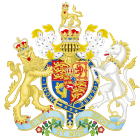Coinage Act 1816 facts for kids
| Act of Parliament | |

|
|
| Long title | An Act to provide for a New Silver Coinage, and to regulate the Currency of the Gold and Silver Coin of this Realm. |
|---|---|
| Citation | 56 Geo. 3. c. 68 |
| Territorial extent | United Kingdom of Great Britain and Ireland |
Quick facts for kids Dates |
|
| Royal assent | 22 June 1816 |
| Other legislation | |
| Repealed by | Coinage Act 1870 |
|
Status: Repealed
|
|
| Text of statute as originally enacted | |
The Coinage Act 1816, also known as the Coin Act 1816 or Liverpool's Act, was an important law passed in the United Kingdom. It helped set the value of the British currency, the pound sterling, by linking it directly to gold. This act was a big step in how money was used in Britain.
What Was the Coinage Act 1816?
This law, passed on June 22, 1816, officially decided how much a British pound sterling was worth in gold. It said that one troy pound (a special unit for weighing precious metals) of standard 22-carat gold was equal to £46 14 shillings and 6 pence.
This amount was also known as 44 and a half guineas. A guinea was another type of British coin, and its value had been set at £1 1 shilling back in December 1717.
Why Was This Act Needed?
Before this act, there were some problems with British money. Silver coins were becoming less valuable than their face value. This meant people might try to melt down silver coins to sell the metal, which was worth more than the coin itself.
The government wanted to make sure that money was stable and trusted. They also wanted to make sure that people couldn't cheat the system by melting down coins.
What Did the Act Do?
The Coinage Act 1816 had two main goals:
- It stopped people from using silver coins for very large payments. If a payment was more than 40 shillings (which was £2), it could not be made using silver coins. This was because the new silver coins were made lighter, with 66 shillings worth of silver in a troy pound instead of 62 shillings.
- It officially created a single gold standard for all money transactions. This meant that the value of the British pound was now firmly based on a fixed amount of gold. This made the currency more stable and predictable.
The gold standard meant that paper money could be exchanged for a specific amount of gold. This gave people confidence in the value of their money.
See also

